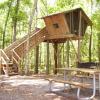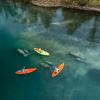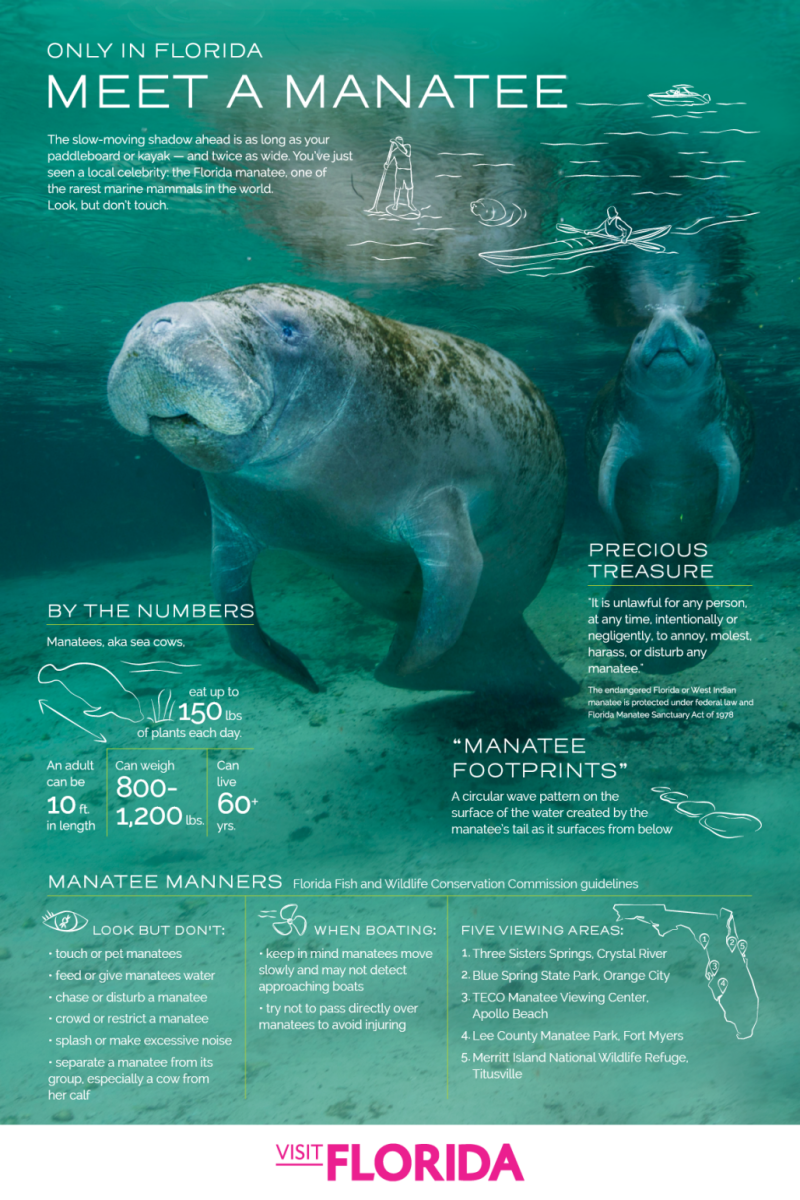Where and How to See Manatees in Florida
By Kevin Mims
Manatees roam the waters of Florida from April through October -- but when things get a bit chilly, they head to places like freshwater Florida Springs, where the temperatures remain constant throughout the year.
It may not seem warm when you jump into a freshwater spring, but the water temperatures remain around 70 degrees, which is perfect for manatees in Florida who need that kind of warmth to survive.
Ready to see some manatees in Florida? Here are several great places to check out:
Three Sisters Springs, Crystal River
If you haven't been to Three Sisters Springs, you're missing out. It's a year-round favorite of mine, and in the winter, manatees come in huge numbers. Kayak or take a boat tour to the springs. I've counted more than 100 manatees in the area at one time. With a concentration of Florida manatees like this, you can imagine that there's also a large concentration of people. Remember, be respectful and observe from a distance. Just down the road in Homosassa Springs, it's a little less crowded, with a number of tours, including Blue Heaven River Tours, to get you up close to the charming sea cows.
Blue Spring State Park, Orange City
Blue Spring State Park gets my vote for the best "no boat needed" manatee viewing location. During manatee season, the spring run is closed -- but there are several overlooks and boardwalks along the way. Make a day of exploring the park and watching the manatees. Bring your camera because there are great pictures to be taken and memories to be made.
TECO Manatee Viewing Center, Apollo Beach
Tampa Electric's Manatee Viewing Center is a designated manatee sanctuary to which large numbers of manatees in Florida return annually to the warm discharge waters of the Big Bend Power Station. Viewing platforms, tidal walkways, and an environmental education center are located at this 50-acre facility.
Lee County Manatee Park, Fort Myers
Located across from Florida Power and Light and directly on the warm water discharge canal, Manatee Park is another wintertime haven where large concentrations of Florida manatees can be seen. Several viewing areas, a butterfly garden, and picnic shelters are available.
Merritt Island National Wildlife Refuge, Titusville
The Haulover Canal connects Mosquito Lagoon and the Indian River, and on the east side of the bridge is a manatee observation area. Viewing platforms, interpretive signs, a boat ramp, and a polarized viewer are located at the observation area.
Manatee Lagoon – An FPL Eco-Discovery Center®, Riviera Beach
Manatee Lagoon is a free Palm Beach County educational attraction with a dedicated area for viewing manatees up close. The waterfront center features engaging, hands-on exhibits for visitors to learn all about these threatened and unique gentle giants as well as the natural wonders of the surrounding Lake Worth Lagoon. On cold winter days, the facility’s observation deck is the ideal spot to view manatee herds basking in the warm-water outflows from Florida Power & Light Company’s adjacent Riviera Beach Next Generation Clean Energy Center.
The Boat Basin at The Deering Estate, Miami
The boat basin fronting the Deering Estate on Biscayne Bay is a great place in Miami to see manatees. The supply of fresh water combined with the calm nature of the bay allow manatees to congregate and mate here. You may also see sea sharks, turtles, rays, and even dolphins. But take looks only - the marine life in the waters here are fragile so no watercraft of any kind are allowed.
FREQUENTLY ASKED QUESTIONS
Where are some places to see manatees in Florida?
Florida offers numerous locations to observe manatees in their natural habitats. Notable sites include Three Sisters Springs in Crystal River, Blue Spring State Park in Orange City, Manatee Park in Fort Myers, and the TECO Manatee Viewing Center in Apollo Beach. Each of these locations provides unique opportunities to witness these gentle giants, especially during the cooler months when manatees seek warmer waters. Additionally, there are many other spots across the state where manatees
When is the best time of year to see manatees in Florida?
The optimal period to view manatees in Florida is during the winter months, typically from mid-November through March. During this time, manatees congregate in warm-water refuges, such as natural springs and power plant outflows, to escape the colder temperatures of open waters. These gatherings provide excellent viewing opportunities for visitors.
Can I swim with manatees in Florida?
Swimming with manatees is permitted in specific areas, most notably in Crystal River, which is renowned for its manatee population. However, interactions are regulated to ensure the safety and well-being of the animals. Participants are required to engage in passive observation, maintaining a respectful distance and avoiding any actions that could disturb the manatees. It's essential to follow all guidelines and regulations when engaging in such activities.
Are manatees dangerous or aggressive?
Manatees are known for their gentle and docile nature. They pose no threat to humans and are often curious, sometimes approaching swimmers or kayakers. However, it's crucial to remember that they are protected wild animals, and interactions should always be conducted responsibly and respectfully.
What should I do if I see a manatee in distress or injured?
If you encounter a manatee that appears to be injured or in distress, it's important to report it immediately. In Florida, you can contact the Florida Fish and Wildlife Conservation Commission (FWC) by calling 1-888-404-FWCC (3922). Prompt reporting can aid in the rescue and rehabilitation of these protected animals.
Why do manatees gather near power plants during winter?
During colder months, manatees seek out warm-water refuges to maintain their body temperature. Power plants discharge warm water as part of their cooling processes, creating environments that attract manatees. Facilities like the Manatee Lagoon in Riviera Beach have become popular spots for manatee viewing during winter.
What do manatees eat, and how much do they consume daily?
Manatees are herbivores, feeding primarily on aquatic vegetation such as seagrasses and freshwater plants. An adult manatee can consume up to 10-15 percent of its body weight in vegetation each day, which equates to approximately 50-150 pounds of food.
How long do manatees live, and what are their main threats?
Manatees can live up to 60 years in the wild. However, they face several threats, including boat collisions, habitat loss, entanglement in fishing gear, and exposure to cold temperatures. Conservation efforts are ongoing to mitigate these risks and protect manatee populations.
Are there educational centers in Florida where I can learn more about manatees?
Yes, Florida hosts several educational centers dedicated to manatee conservation and education. The Manatee Lagoon in West Palm Beach and the Manatee Observation and Education Center in Fort Pierce offer interactive exhibits and viewing areas. These centers provide valuable information about manatees and their habitats.
What are some family-friendly activities related to manatees in Florida?
Families can enjoy various manatee-related activities across Florida. Options include guided kayak tours in Crystal River, boardwalk viewing at Blue Spring State Park, and educational programs at facilities like the Manatee Lagoon. These experiences offer both fun and educational opportunities for visitors of all ages.
Can I feed the manatees?
No, feeding manatees is illegal in Florida. Manatees are protected under both state and federal law, and feeding them can disrupt their natural behaviors, make them dependent on humans, and increase the risk of boat strikes by encouraging them to linger near docks and marinas. It's also illegal to give them water from hoses or to attempt to pet or touch them. The best way to help is to observe from a distance and report any manatees in distress to wildlife officials.
How are manatees protected under the law?
Manatees are protected under multiple laws, including the Marine Mammal Protection Act, the Endangered Species Act, and the Florida Manatee Sanctuary Act. These laws make it illegal to harass, hunt, capture, or kill manatees. Additionally, there are designated manatee protection zones throughout Florida, especially in areas with high boat traffic, where speed limits are enforced seasonally or year-round to reduce the risk of injury from watercraft.
Do manatees have any natural predators?
Manatees have very few natural predators. Their large size and slow metabolism make them less attractive to most predators. In rare cases, calves may be vulnerable to large sharks or alligators, but these incidents are very uncommon. The greatest threats to manatees today are human-related, such as boat collisions, habitat loss, red tide events, cold stress, and entanglement in fishing lines or crab trap ropes.



























